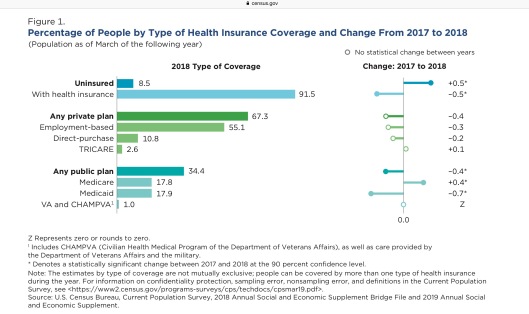Tags
Bernie Sanders, EU, health insurance, Health insurance coverage, healthcare coverage Europe, Insurance by types, insurance in OECD countries, Insured rate, medicaid, Medicare, Medicare for all, OECD, OECD healthcare, private health insurance, Switzerland, uninsured rate, US health insurance coverage

The extremely poor and the disabled are covered by Medicaid in the United States, and senior citizens are covered Medicare and/or Medicaid. The chart below shows the types of health coverage in OECD countries. Bernie Sanders continues to mislead people on this topic. As can be seen, there is great variation. Many countries force their citizens to buy health insurance, i.e. “compulsory health insurance“, as can be seen below. If they are forced by law to buy health insurance, of course they are covered by health insurance! Some of this health insurance coverage only allows treatment within the local county or region, so that it is cheaper. This most basic insurance is non-profit. Such is the case for Switzerland, which WHO says still spends more than the US on health. The OECD says it spends a bit less: https://en.wikipedia.org/wiki/List_of_countries_by_total_health_expenditure_per_capita. Bernie’s brother Larry Sanders is very worried about the financing and risk of privatization of the much cheaper British NHS system. So, Bernie should know very well the pitfalls of funding shortfalls, and yet he ignores them.

P. 10 http://www.oecd.org/officialdocuments/publicdisplaydocumentpdf/?cote=COM/DELSA/GOV(2019)2&docLanguage=En
None of these have the massive and highly centralized system that Bernie Sanders’ “Medicare for All” proposes. See: https://miningawareness.wordpress.com/2020/02/26/healthcare-expenditure-by-type-of-financing-oecd-countries-government-compulsory-health-insurance-voluntary-health-insurance-out-of-pocket/
In the US, the foreign born are more likely to be uninsured: https://www.dhs.gov/sites/default/files/publications/ForeignBorn%20Component%20of%20the%20Uninsured%20Population.pdf More up to date information on foreign born children, found at the link below.
“Health Insurance Coverage in the United States: 2018
NOVEMBER 08, 2019
REPORT NUMBER P60-267 (RV)
EDWARD R. BERCHICK, JESSICA C. BARNETT, AND RACHEL D. UPTON
Introduction
Download Healh Insurance Coverage in the United States: 2018 [PDF – 1.0 MB]
https://www.census.gov/content/dam/Census/library/publications/2019/demo/p60-267.pdf
This report presents statistics on health insurance coverage in the United States based on information collected in the Current Population Survey Annual Social and Economic Supplement (CPS ASEC) and the American Community Survey (ACS).
User Note
This report was originally published on September 10, 2019. Table 6 was revised. In the previously published report, the rounded 2018 American Community Survey estimate for the total number of uninsured people in the United States was listed at 28,554,000. The revised report includes the correct rounded estimate of 28,566,000. The difference did not affect the uninsured rate.
Highlights
• In 2018, 8.5 percent of people, or 27.5 million, did not have health insurance at any point during the year. The uninsured rate and number of uninsured increased from 2017 (7.9 percent or 25.6 million).
• The percentage of people with health insurance coverage for all or part of 2018 was 91.5 percent, lower than the rate in 2017 (92.1 percent). Between 2017 and 2018, the percentage of people with public coverage decreased 0.4 percentage points, and the percentage of people with private coverage did not statistically change.
• In 2018, private health insurance coverage continued to be more prevalent than public coverage, covering 67.3 percent of the population and 34.4 percent of the population, respectively. Of the subtypes of health insurance coverage, employer-based insurance remained the most common, covering 55.1 percent of the population for all or part of the calendar year.
• Between 2017 and 2018, the percentage of people covered by Medicaid decreased by 0.7 percentage points to 17.9 percent. The rate of Medicare coverage increased by 0.4 percentage points. The percentage of people with employment-based coverage, direct-purchase coverage, TRICARE, and VA or CHAMPVA health care did not statistically change between 2017 and 2018.
• The percentage of uninsured children under the age of 19 increased by 0.6 percentage points between 2017 and 2018, to 5.5 percent.
• Between 2017 and 2018, the percentage of people without health insurance coverage at the time of interview decreased in three states and increased in eight states.” https://www.census.gov/library/publications/2019/demo/p60-267.html

You must be logged in to post a comment.